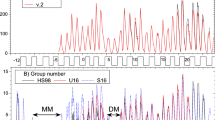Abstract
A correlation between a global average of low cloud cover and the flux of cosmic rays incident in the atmosphere has been observed during the last solar cycle. The ionising potential of Earth bound cosmic rays are modulated by the state of the heliosphere, while clouds play an important role in the Earth's radiation budget through trapping outgoing radiation and reflecting incoming radiation. If a physical link between these two features can be established, it would provide a mechanism linking solar activity and Earth's climate. Recent satellite observations have further revealed a correlation between cosmic ray flux and low cloud top temperature. The temperature of a cloud depends on the radiation properties determined by its droplet distribution. Low clouds are warm (>273 K) and therefore consist of liquid water droplets. At typical atmospheric supersaturations (∼1%) a liquid cloud drop will only form in the presence of an aerosol, which acts as a condensation site. The droplet distribution of a cloud will then depend on the number of aerosols activated as cloud condensation nuclei (CCN) and the level of super saturation. Based on observational evidence it is argued that a mechanism to explain the cosmic ray-cloud link might be found through the role of atmospheric ionisation in aerosol production and/or growth. Observations of local aerosol increases in low cloud due to ship exhaust indicate that a small perturbation in atmospheric aerosol can have a major impact on low cloud radiative properties. Thus, a moderate influence on atmospheric aerosol distributions from cosmic ray ionisation would have a strong influence on the Earth's radiation budget. Historical evidence over the past 1000 years indicates that changes in climate have occurred in accord with variability in cosmic ray intensities. Such changes are in agreement with the sign of cloud radiative forcing associated with cosmic ray variability as estimated from satellite observations.
Similar content being viewed by others
References
Ardanuy, P., Stowe, L.L., Gruber, A., and Weiss, M.: 1991, ‘Shortwave, longwave, and net cloudradiative forcing as determined from Nimbus-7 observations’, J. Geophys. Res. 96, 18,537.
Geller, M.A., and Alpert, J.C.: 1980, ‘Planetary wave coupling between the troposphere and the middle atmosphere as a possible sun–weather mechanism’, J. Atmos. Sci. 37, 1197.
Haigh, J.D.: 1996, ‘The impact of solar variability on climate’, Science 272, 981.
Hartmann, D.L.: 1993, Radiative effects of clouds on Earth's climate, in Aerosol-Cloud-Climate Interactions, Academic Press.
Herman, J.R., and Goldberg, R.A.: 1978, Sun, Weather, and Climate, NASA SP 426.
Heymsfield, A.J.: 1993, Microphysical Structures of Stratiform and Cirrus Clouds, in Aerosol-Cloud-Climate Interactions, Academic Press.
Hõrrak, U., Salm, J., and Tammet, H.: 1998, ‘Bursts of intermediate ions in atmospheric air’, J. Geophys. Res. 103, 13,909.
King, M.D., Radke, L.F., and Hobbs, P.V.: 1993, ‘Optical properties of marine stratocumulus clouds modified by ships’, J. Geophys. Res. 98, 2729.
Lal, D., and Peters, B.: 1967, ‘Cosmic ray produced radioactivity on the Earth’, in Encyclopaedia of Physics, Springer-Verlag, Berlin.
Lean, J., Beer, J., and Bradley, R.: 1995, ‘Reconstruction of solar irradiance since 1610: Implications for climate change’, Geophys. Res. Lett. 22, 3195.
Lockwood, M., Stamper, R., and Wild M.N.: 1999, ‘A doubling of the Sun's coronal magnetic field during the past 100 years’, Nature 399, 437.
Lockwood, M. and Stamper, R.: 1999, ‘Long-term drift of the coronal source magnetic flux and the total solar irradiance’, Geophys. Res. Lett. 26, 2461.
Marsh, N.D. and Svensmark, H.: 2000, ‘Low cloud properties influenced by solar activity’, Phys. Rev. Lett., submitted.
Neher, H.V.: 1971, ‘Cosmic-Rays at high latitudes and altitudes covering four solar maxima’, J. Geophys. Res. 76, 1637.
Ney, E.R.: 1959, ‘Cosmic radiation and the weather’, Nature 183, 451.
Ohring, G., and Clapp, P.F.: 1980, ‘The effect of changes in cloud amount on the net radiation at the top of the atmosphere’, J. Atmos. Sci. 37, 447.
Pruppacher, H.R., and Klett, J.D.: 1997, Microphysics of Clouds and Precipitation, Kluwer, Dordrecht.
Ramanathan, V., et al.: 1989, ‘Results from the Earth's radiation budget experiment’, Science 243, 57.
Rossow, W.B., and Schiffer, R.A.: 1991, ‘ISCCP Cloud Data Products’, Bull. Am. Met. Soc. 72, 2.
Rossow, W.B., Walker, A.W., Beuschel, D.E., and Roiter, M.D.: 1996, International Satellite Cloud Climatology Project (ISCCP): Documentation of New Cloud Datasets, World Meteorological Organization, Geneva.
Schiffer, R.A., and Rossow, W.B.: 1983 ‘The International Satellite Cloud Climatology Project (ISCCP): The first project of the World Climate Research Programme’, Bull. Am. Met. Soc. 64, 779.
Schiffer, R.A., and Rossow, W.B.: 1985, ‘ISCCP Global Radiance Data Set: A New Resource for Climate Research’, Bull. Am. Met. Soc. 66, 1498.
Shindell, D., Rind, D., Balabhandran, N., Lean, J., and Lonergan, P.: 1999, ‘Solar cycle variability, ozone, and climate’, Science 284, 305.
Stowe, L.L., Wellemayer, C.G., Eck, T.F., Yeh, H.Y.M., and the Nimbus-7 team: 1988, J. Clim. 1, 445.
Svensmark, H., and Friis-Christensen, E.: 1997, ‘Variation of Cosmic Ray Flux and Global Cloud Coverage – A Missing Link in Solar-Climate Relationships’, J. Atm. Sol. Terr. Phys. 59, 1225.
Svensmark, H.: 1998, ‘Influence of cosmic rays on climate’, Phys. Rev. Lett. 81, 5027.
Turco, R.P., Zhao, J.-X., and Yu, F.: 1998, ‘A new source of tropospheric aerosols: Ion-ion recombination’, Geophys. Res. Lett. 25, 635.
Viggiano, A.A., and Arnold, F.: 1995, Ion Chemistry and Composition of the Atmosphere, in Handbook of Atmospheric Electrodynamics, CRC Press.
Weng, F., and Grody, N.C.: 1994, J. Geophys. Res. 99, 25,535.
Yu, F., and Turco, R.P.: 2000, ‘Ultrafine aerosol formation via ion-mediated nucleation’, Geophys. Res. Lett. 27, 883.
Author information
Authors and Affiliations
Rights and permissions
About this article
Cite this article
Marsh, N., Svensmark, H. Cosmic Rays, Clouds, and Climate. Space Science Reviews 94, 215–230 (2000). https://doi.org/10.1023/A:1026723423896
Issue Date:
DOI: https://doi.org/10.1023/A:1026723423896




